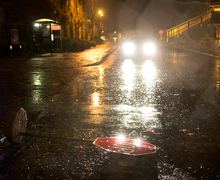Upon further review
Syracuse football head coach Greg Robinson has had a front-row seat to the instant replay debate. He’s seen calls overturned in the National Football League based on disputable evidence. He’s also seen routine challenges slow down the game and other calls left unchallenged.
Robinson, who spent eight years between 1995 and 2003 as a defensive coordinator in the NFL for the Kansas City Chiefs and Denver Broncos, knows instant replay can help the game. He also knows there are detriments.
‘I’ve been through the bad part of instant replay and the good part,’ Robinson said. ‘If used correctly, it can improve the game. But it’s not perfect.’
Robinson will have a chance to see the argument play out in Big East football starting this fall.
The Big East announced last week that it unanimously approved the use of instant replay for league games. The Big East is the fourth conference this off-season to approve instant replay, joining the Big Ten, which began using a replay system last season. More conferences are expected to approve a trial instant replay system.
‘We have done significant research and analysis into the use of instant replay for our conference football games for the coming season,’ Big East Commissioner Mike Tranghese said in a statement. ‘Our football coaches and athletic directors endorse the concept of instant replay earlier this year. … We’re perusing what we think will be the best possible system for the coming season.’
Each school has been shown a demonstration of the replay system. Associate Commissioner Nick Carparelli and Supervisor of Officials John Soffey will oversee the program and iron the kinks out this summer with each school.
The league is billing Syracuse’s season-opener against West Virginia on ABC as the first game for the replay plan. But that game could fall on Saturday or, more likely, Sunday afternoon, so a slate of Big East games from Saturday could be first to utilize the setup.
Out-of-conference home games for Big East schools are the only games that might not use replay. Each school will ask its out-of-conference opponents for permission.
Syracuse complied with Purdue and the Big Ten’s request to use instant replay in its matchup in West Lafayette, Ind., last year. SU and future Big East member Cincinnati were the only two teams to participate in a Big Ten road game last year. Neither game featured a reviewed call.
The Big Ten was the lone conference to use instant replay during the 2004 season. The Mountain West, Atlantic Coast, Southeastern and Pacific 10 conferences joined the Big East in approving instant replay for the upcoming season.
Carparelli said the NCAA is allowing conferences to implore a trial replay system and provide feedback. He said after a trial, the NCAA might agree to a unified country-wide instant replay system.
The Big East began researching an instant replay plan at the beginning of last year after the Big Ten announced its plan. The conference hired a firm to develop the system, though many of the details are still being finalized, Carparelli said.
‘It was quite obvious this would allow more correct calls,’ Carparelli said. ‘The schools have been very supportive.’
For the most part, the system will follow the Big Ten’s model. An eighth official will be in a private booth in an upper section of the stadium, initiating all reviews. A booth has to be secured in each stadium and the necessary video feeds installed.
The conference will make campus visits this summer to train and educate personnel on how to use the system.
Carparelli said the education aspect of the plan is the most extensive and time consuming aspect of the plan.
But another major issue deals with the replays themselves. In the NFL, a game that does not have as many television cameras can suffer with the quality of replays available to officials. A game on national television utilizes a plethora of cameras, but a regional game will have considerably fewer.
It becomes more of a problem for the Big East, where games don’t receive the amount of television attraction they do in the NFL, or sometimes no television at all.
The Big Ten had every game televised last season so there was never a problem with no television presence. But the difference between national coverage and local can be significant with the number and quality of replays.
‘We’re still in the process of working that out,’ Carparelli said. ‘In the event there’s no TV, we’re in the process of using in-game video boards.’
Additional cameras might be used so that non-televised games can still utilize replay efficiently. As it stands now, a non-televised game in the Carrier Dome would utilize the existing cameras that are only used for replays and game feeds on the video boards.
Another issue with replay is whether officiating will change. Some have said that officials are less likely to make a call because replay is an available crutch to overturn it.
Carparelli dismissed that notion.
‘Every official wants to get the calls right,’ Carparelli said. ‘Often the mistaken calls are something a human being just couldn’t see.’
All aspects of the replay system will be evaluated at the end of the season.
In the meantime, it’s likely numerous fans will applaud the system, especially when an incorrect call is overturned. In the past, fans would have left with a bitter taste in their mouths. Now they can leave satisfied knowing their team lost on the merits of its poor play – not the officiating.
‘The ideal outcome is to increase the number of correct calls,’ Carparelli said. ‘If there are no calls that need to be corrected, that’s fine. If there are incorrect calls that are corrected, that’s probably even better.’
Published on March 27, 2005 at 12:00 pm





